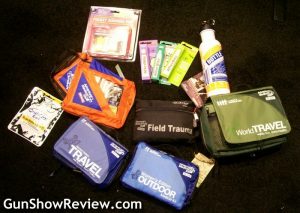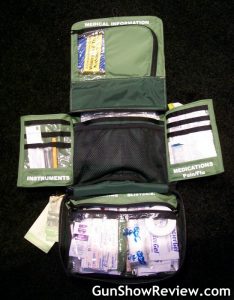Basic First-Aid Kit Items
Here is a First-Aid Checklist
the ten essentials of a first aid kit

Bandages
- Assorted Adhesive Bandages
- Gauze
- Athletic Tape
- Blister Treatments (moleskin)
- Burn dressing
- Splints and elastic wraps
Include emergency items: Consider including emergency items like a whistle, emergency blanket, or flashlight in your first aid kit in case of a larger emergency.
Medication and ointments/lotions
Add medications: Consider including medications like pain relievers, antihistamines, and antacids in your first aid kit.
- Ibuprofen
- Antibiotic ointments
- Antacid tablets
- Antidiarrheal pills
- Rehydration salts
- Prescription Medicines
- Antiseptic towelettes
- sunscreen
- bug repellent
Check the expiration dates: Make sure to regularly check the expiration dates on all the items in your first aid kit, including medications, ointments, and bandages. Replace any items that have expired or are about to expire.

Basic tools
Include basic supplies: Your first aid kit should include basic supplies like bandages, antiseptic wipes, and gauze pads.
- Headlamp or Flashlight
- CPR breathing barrier
- Tweezers
- Small mirror
- Blunt tip scissors
- Razor blade or knife
- Bee-sting kit
- Tick remover
- A whistle
- Heat-Reflecting Blanket
Customize your kit: Customize your first aid kit to your specific needs, including any medications or supplies that you or your family members may need.
Advanced Tools
Include tools: Add tools like scissors, tweezers, and a thermometer to your first aid kit to help you treat injuries more effectively.
- Personal Locator Beacon
- Satellite Messenger
Consider your environment: If you spend a lot of time outdoors, consider including items like sunscreen, insect repellent, and a snake bite kit in your first aid kit.
First-Aid Training
- Outdoor first-aid courses
- wilderness medicine classes
Train your family: Make sure your family members know how to use the items in your first aid kit and how to respond in case of an emergency. Consider taking a first aid class to learn more about how to provide first aid effectively.

Keep it organized: Keep your first aid kit organized and easy to use. Use compartments or clear bags to separate different items.
Keep it visible: Keep your first aid kit in a visible and accessible location, so you can easily find it when you need it.
Update as needed: Regularly review and update your first aid kit, especially after using it or after any changes in your family’s health or medication needs.
Include information: Include information like emergency contact numbers, first aid instructions, and any important medical information in your first aid kit.